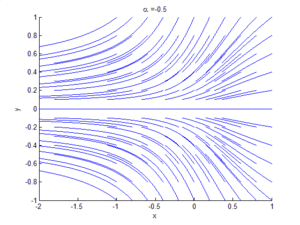Bifurcation theory is the mathematical study of changes in the qualitative or topological structure of a given family of curves, such as the integral curves of a family of vector fields, and the solutions of a family of differential equations. Most commonly applied to the mathematical study of dynamical systems, a bifurcation occurs when a small smooth change made to the parameter values (the bifurcation parameters) of a system causes a sudden 'qualitative' or topological change in its behavior.[1] Bifurcations occur in both continuous systems (described by ordinary, delayorpartial differential equations) and discrete systems (described by maps).

The name "bifurcation" was first introduced by Henri Poincaré in 1885 in the first paper in mathematics showing such a behavior.[2]
It is useful to divide bifurcations into two principal classes:
A local bifurcation occurs when a parameter change causes the stability of an equilibrium (or fixed point) to change. In continuous systems, this corresponds to the real part of an eigenvalue of an equilibrium passing through zero. In discrete systems (described by maps), this corresponds to a fixed point having a Floquet multiplier with modulus equal to one. In both cases, the equilibrium is non-hyperbolic at the bifurcation point. The topological changes in the phase portrait of the system can be confined to arbitrarily small neighbourhoods of the bifurcating fixed points by moving the bifurcation parameter close to the bifurcation point (hence 'local').
More technically, consider the continuous dynamical system described by the ordinary differential equation (ODE)
For discrete dynamical systems, consider the system
Examples of local bifurcations include:
Global bifurcations occur when 'larger' invariant sets, such as periodic orbits, collide with equilibria. This causes changes in the topology of the trajectories in the phase space which cannot be confined to a small neighbourhood, as is the case with local bifurcations. In fact, the changes in topology extend out to an arbitrarily large distance (hence 'global').
Examples of global bifurcations include:
Global bifurcations can also involve more complicated sets such as chaotic attractors (e.g. crises).
The codimension of a bifurcation is the number of parameters which must be varied for the bifurcation to occur. This corresponds to the codimension of the parameter set for which the bifurcation occurs within the full space of parameters. Saddle-node bifurcations and Hopf bifurcations are the only generic local bifurcations which are really codimension-one (the others all having higher codimension). However, transcritical and pitchfork bifurcations are also often thought of as codimension-one, because the normal forms can be written with only one parameter.
An example of a well-studied codimension-two bifurcation is the Bogdanov–Takens bifurcation.
Bifurcation theory has been applied to connect quantum systems to the dynamics of their classical analogues in atomic systems,[6][7][8] molecular systems,[9] and resonant tunneling diodes.[10] Bifurcation theory has also been applied to the study of laser dynamics[11] and a number of theoretical examples which are difficult to access experimentally such as the kicked top[12] and coupled quantum wells.[13] The dominant reason for the link between quantum systems and bifurcations in the classical equations of motion is that at bifurcations, the signature of classical orbits becomes large, as Martin Gutzwiller points out in his classic[14] work on quantum chaos.[15] Many kinds of bifurcations have been studied with regard to links between classical and quantum dynamics including saddle node bifurcations, Hopf bifurcations, umbilic bifurcations, period doubling bifurcations, reconnection bifurcations, tangent bifurcations, and cusp bifurcations.